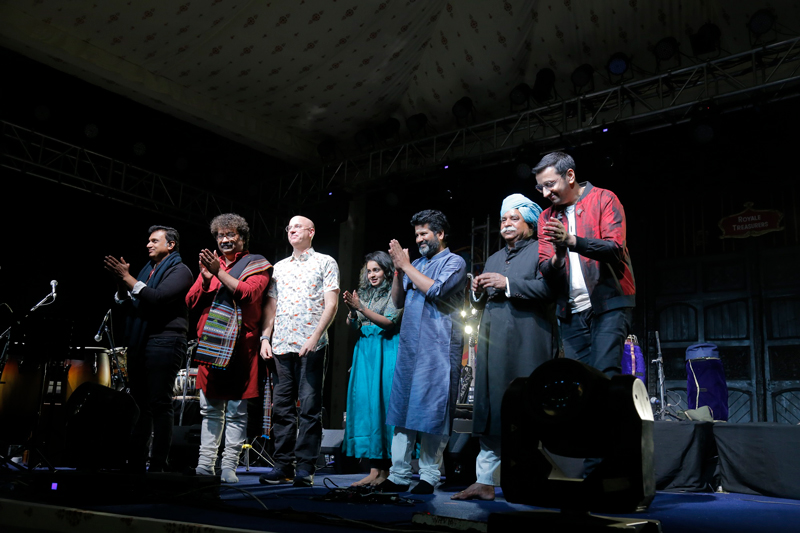(headline image: MPF- Rhythms of India)
Over the years, the Mahindra Group of manufacturing, agricultural and IT companies has organized a range of outstanding cultural festivals in India. These include the Mahindra Theatre Festival, Mahindra Kabira Festival, Mahindra Blues Festival, and Mahindra Roots Festival.
The second edition of the Mahindra Percussion Festival (MPF) kicks off in Bangalore this weekend, with a spectacular range of performers from across India.

Last year, the inaugural edition was for a day (see our writeup here) – this year, it spans two days at the Prestige Srihari Khoday Centre for Performing Arts.
Highlighting the line-up is Vikku Vinayakram’s Ghatam Symphony, alongside Grammy winner V Selvaganesh, Swaminathan Selvaganesh, and V Umashankar. Taufiq Qureshi’s Surya ensemble will explore global percussion sounds, blending Afro, Latin, Indian, and contemporary music.

Anantha R Krishana and Vivieck Rajagopalan’s Two Summ will offer a unique fusion of the mridangam with electronic, drum and bass, jazz, and folk. Ashtanayika – Kal Aur Aaj bridges classical and contemporary arts through a fusion of poetry, rap, and dance.

Indian folk music is well-profiled with the Rhythms of India ensemble, Swarathma Percussive Experience, and Charu Hariharan’s collaboration with Kattunaykkar Jenukuruba and Kozhikode Nanthalakootam.

“An entire festival that has its focus on percussion is in itself a very unique idea,” Jay Shah, Vice President – Cultural Outreach, Mahindra Group, tells World Music Central.
“It becomes a true celebration of the art form when we marry this idea with the vision to bring forth relatively unknown percussive instruments and individuals and communities that play them,” he adds.
“The percussion music art form, in India alone, has an expanse that ranges across the country through different playing styles and instruments. It is the festival’s objective to bring every style and unique instrument to the forefront,” says VG Jairam, Founder of cultural production firm Hyperlink Brand Solutions.

Percussionist, singer, and composer Charu Hariharan put together a percussion ensemble exclusively for MPF 2024. “I’ve worked with all these artists on different projects on different occasions, but they’ve all come together as a team for the first time,” she explains.
Her introduction to folk and tribal music was through an archiving project called Earthlore. “Even though my foundation in vocal and percussion has been Carnatic music, I’ve had the opportunity to learn and perform different genres such as folk, world, jazz, contemporary, and Hindustani, to name a few,” she describes.
She also worked for movies as a session artist, composer and producer, and directed music for dance and theater projects.

In Two Summ, Anantha Krishnan and Viveick Rajagopalan showcase a new method outside the Carnatic idiom to engage with two mridangams, along with looping and digital effects.
“The Indian percussion world is massive if one looks at how each state has its own folk and classical music culture,” Viveick Rajagopalan describes. He recalls how he had a chance conversation and some email exchanges with Anantha.
“We presented our first festival MridangaMela back in 2019. We have had our share of individualistic journeys, which are completely different and that allows us room to collaborate and explore further,” Viveick explains.
“My musical journey is like a bhel puri, which is a Mumbai chaat snack,” he jokes.
“It’s a mix of things yet has its own identity. From learning mridangam to collaborating with artists across genres and releasing my own EP/album as a composer and producer, it’s all a bhel puri,” Viveick explains.

Varijashree Venugopal of Rhythms of India has participated in a number of festivals curated by Teamwork Arts. This includes her trio Trayam with B C Manjunath and Praveen D Rao, who performed at one of the editions of the renowned Jaipur Literature Festival.
The Rhythms of India lineup includes Nathulal Solanki, Pramath Kiran and Darshan Doshi. “Indian music has a rich heritage of various styles and schools of percussion instruments. It is very essential to showcase this,” she affirms.
“Each of us comes from a background of training in some form of Indian classical music, with a learning and performing experience of over 25 years. We share a common aim of applying the fundamentals of our training into new and unexplored formats,” Varijashree explains.
She sees Indian classical music thriving among Indian youth as well as path-breaking applications of Indian classical music in the global music scene. “Another wonderful thing about the Indian music scene today is how every genre of music has a discerning audience,” she adds.
“My message to the audiences of India is of gratitude, for carrying such an open heart. The audience’s transparent reception facilitates artistes like us to explore our creativity to the fullest extent and to provide an extraordinary artistic experience,” Varijashree signs off.



